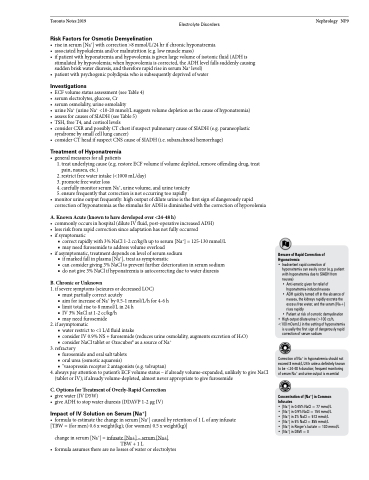Page 709 - TNFlipTest
P. 709
Toronto Notes 2019 Electrolyte Disorders
Risk Factors for Osmotic Demyelination
• riseinserum[Na+]withcorrection>8mmol/L/24hrifchronichyponatremia
• associatedhypokalemiaand/ormalnutrition(e.g.lowmusclemass)
• ifpatientwithhyponatremiaandhypovolemiaisgivenlargevolumeofisotonicfluid(ADHis
stimulated by hypovolemia; when hypovolemia is corrected, the ADH level falls suddenly causing
sudden brisk water diuresis, and therefore rapid rise in serum Na+ level)
• patientwithpsychogenicpolydipsiawhoissubsequentlydeprivedofwater
Investigations
• ECFvolumestatusassessment(seeTable4)
• serumelectrolytes,glucose,Cr
• serumosmolality,urineosmolality
• urine Na+ (urine Na+ <10-20 mmol/L suggests volume depletion as the cause of hyponatremia) • assessforcausesofSIADH(seeTable5)
• TSH,freeT4,andcortisollevels
• considerCXRandpossiblyCTchestifsuspectpulmonarycauseofSIADH(e.g.paraneoplastic
syndrome by small cell lung cancer)
• considerCTheadifsuspectCNScauseofSIADH(i.e.subarachnoidhemorrhage)
Treatment of Hyponatremia
• generalmeasuresforallpatients
1. treat underlying cause (e.g. restore ECF volume if volume depleted, remove offending drug, treat
pain, nausea, etc.)
2. restrict free water intake (<1000 mL/day)
3. promote free water loss
4. carefully monitor serum Na+, urine volume, and urine tonicity 5. ensure frequently that correction is not occurring too rapidly
• monitorurineoutputfrequently:highoutputofdiluteurineisthefirstsignofdangerouslyrapid correction of hyponatremia as the stimulus for ADH is diminished with the correction of hypovolemia
A. Known Acute (known to have developed over <24-48 h)
• commonlyoccursinhospital(diluteIVfluid,post-operativeincreasedADH) • lessriskfromrapidcorrectionsinceadaptationhasnotfullyoccurred
• ifsymptomatic
■ correct rapidly with 3% NaCl 1-2 cc/kg/h up to serum [Na+] = 125-130 mmol/L
■ may need furosemide to address volume overload
• ifasymptomatic,treatmentdependsonlevelofserumsodium
■ if marked fall in plasma [Na+], treat as symptomatic
■ can consider giving 3% NaCl to prevent further deterioration in serum sodium ■ do not give 3% NaCl if hyponatremia is autocorrecting due to water diuresis
B. Chronic or Unknown
1. if severe symptoms (seizures or decreased LOC)
■ must partially correct acutely
■ aim for increase of Na+ by 0.5-1 mmol/L/h for 4-6 h ■ limit total rise to 8 mmol/L in 24 h
■ IV 3% NaCl at 1-2 cc/kg/h
■ may need furosemide
2. if asymptomatic
■ water restrict to <1 L/d fluid intake
■ consider IV 0.9% NS + furosemide (reduces urine osmolality, augments excretion of H2O) ■ consider NaCl tablet or Oxocubes® as a source of Na+
3. refractory
■ furosemide and oral salt tablets
■ oral urea (osmotic aquaresis)
■ "vasopressin receptor 2 antagonists (e.g. tolvaptan)
4. always pay attention to patient’s ECF volume status – if already volume-expanded, unlikely to give NaCl (tablet or IV); if already volume-depleted, almost never appropriate to give furosemide
C. Options for Treatment of Overly-Rapid Correction
• givewater(IVD5W)
• giveADHtostopwaterdiuresis(DDAVP1-2μgIV)
Impact of IV Solution on Serum [Na+]
• formulatoestimatethechangeinserum[Na+]causedbyretentionof1Lofanyinfusate [TBW = (for men) 0.6 x weight(kg); (for women) 0.5 x weight(kg)]
change in serum [Na+] = infusate [Na+] – serum [Na+] TBW+1L
Nephrology NP9
Beware of Rapid Correction of Hyponatremia
• Inadvertent rapid correction of
hyponatremia can easily occur (e.g. patient with hyponatremia due to SIADH from nausea)
• Anti-emetic given for relief of
hyponatremia-induced nausea
• ADH quickly turned off in the absence of
nausea, the kidneys rapidly excrete the excess free water, and the serum [Na+] rises rapidly
• Patient at risk of osmotic demyelination • High output dilute urine (>100 cc/h,
<100 mOsm/L) in the setting of hyponatremia
is usually the first sign of dangerously rapid correction of serum sodium
Correction of Na+ in hyponatremia should not exceed 8 mmol/L/24 h unless definitely known to be <24-48 h duration; frequent monitoring
+
ofserumNa andurineoutputisessential
Concentration of [Na+] in Common Infusates
• [Na+] in 0.45% NaCl = 77 mmol/L
• [Na+] in 0.9% NaCl = 154 mmol/L
• [Na+] in 3% NaCl = 513 mmol/L
• [Na+] in 5% NaCl = 855 mmol/L
• [Na+] in Ringer’s lactate = 130 mmol/L • [Na+]inD5W=0
• formulaassumestherearenolossesofwaterorelectrolytes


